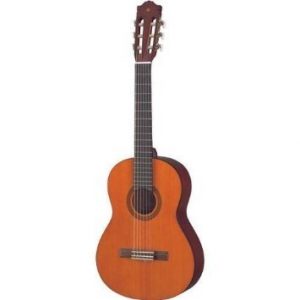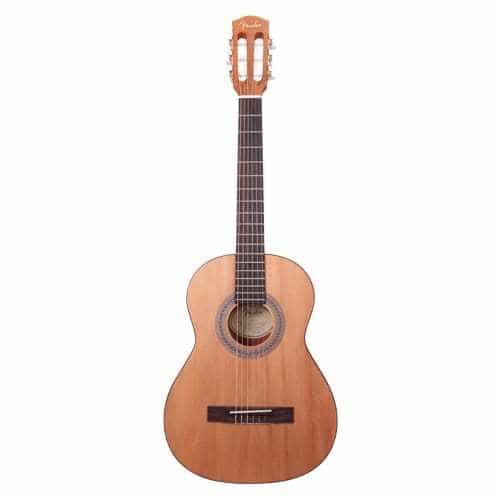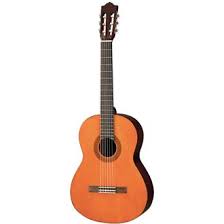The Best Beginner Classical Guitars for Kids
A classical guitar is an acoustic guitar with nylon strings; they are sometimes called Spanish style. They are often recommended as a starter instrument for children because of the small sizes available, and the strings are easier on kid’s fingers than the steel strings of an acoustic. The harsh strings of an acoustic can be a significant deterrent to learning to play, especially for very young children as it can lead to sore fingers and it makes playing very painful.
Nylon strings models often have a wider neck to create more space between the strings, which can be problematic for kids with small hands, although they do tend to have shorter fretboards and smaller bodies which is a feature of a guitar that makes it easier for kids to play.
Best Nylon String Guitars for Kids Top Picks
| Product | About | Review | |
|---|---|---|---|
 | Yamaha CGS102A 1/2 Size Classical | Student 1/2 size guitar. Great for kids ages 5-8 who are taking lessons. | Read the Full Review |
| Cordoba Requinto 580 1/2 Size Acoustic Nylon String Classical Guitar | 1/2 size good quality model. | Read the full review | |
 | Yamaha CGS 3/4 Size Classical | Popular 3/4 size classical style for a child in the 8 to 12 year old age range. Great model for lessons. | Read the Full Review |
 | Valencia 200 Series 3/4 Size Classical Acoustic Guitar Natural | 3/4 sized, well made, and inexpensive model from Valencia. | Read the Full Review |
 | Yamaha C40 GigMaker Classical Acoustic Guitar | Full sized starter guitar for children ages 11 or 12 or older. | Read the Full Review |
Read all our Classical for Kids Reviews.
How to Choose a Beginner Classical Guitar for Kids
Sizing
There are four basic sizes (with a few variations)1/4 size, ½ size, ¾ size, and 4/4 (full) size. While a child can generally learn on a model that is larger than recommended, it is much easier for a young child to get his or her hands around the appropriately sized guitar.
As a general guide
- For a small child, (ages 3 to 6) look for a 1/2 size, or even a ukulele.
- For a medium-sized kid (ages 7 to 12), look for a 3/4 size.
- And for a teen (12 and up) or an adult, a full-size is probably the best choice.
When you are selecting an instrument, you will want your child’s right arm and shoulder to fit comfortably around the body, while the left hand should be able to reach to the end of the neck.
The best way to find the right fit for your child is to go to a music store and try out a few different sizes and models.
Scale length Chart
1/4 size 19″
1/2 size 20.5″
3/4 size 22.75″
4/4 full size 24.75″ or 25.5″
What are the Brands to look for? Brands to Avoid?
Generally, you should avoid any ‘toy’ guitar. These are the kinds of instruments you would find at Toys R Us or Walmart that are usually sold in starter kits. If you want your kids to learn to play, it is well worth investing in a decent guitar that will stay in tune and be easy to play. A big problem with toy brand models is that they don’t stay in tune, which makes for an incredibly frustrating experience if you are trying to learn. You can get some great budget student models from brands like Hohner, Cordoba, and Espana. If you don’t mind paying a little bit more check out Yamaha, Alvarez or Takamine.
What Accessories do I need?
You will want to get some extra strings, a guitar bag, strap, and a tuner.
What is a reasonable price for a beginner classical guitar?
Budget/quality is an important aspect to think about when shopping for an instrument. You need to figure out how much you want to spend to make sure that you receive a high-quality make and model. As with most things, the saying that you get what you pay for is true for guitars. If you want an instrument that will last for several years, sound good, and be easy to learn on, then you should consider spending extra to get a top-quality guitar.
What should I look for when buying a classical guitar for a child?
Neck
Necks on classical models are wider than a regular acoustic model; this can be a problem for some children. If a child can’t wrap their fingers around the neck, it makes it hard to play. Classical necks are also shorter than most acoustics which is good for playability for kids.
Intonation
If you are reading reviews, you will come across the term ‘Intonation.’ Intonation means the accuracy of the pitch or tone of the instrument. You will want to choose a model with excellent intonation.
Tuning Machines
The type of tuning machine your guitar has is critical as this is what allows you to fine tune and hold pitch. Make sure you select a guitar with good quality tuners that are easy for kids to adjust.
Strings
It’s important to note with classical guitars the strings need time to stretch out before they can stay in tune., this usually takes about a week or so. During this time you will have to retune your guitar often because it won’t be able to stay in tune. After a few days, the strings should have stretched out enough to let the guitar stay in tune for a decent period.
Straps
Classical guitars generally don’t come with guitar straps or knobs to attach a strap to, this might be problematic for a kid to play unless they are sitting down.
- Buying Guide for Children’s Acoustic Guitars - January 1, 2020
- The Best Guitars for Kids (Buying Guide) - May 23, 2018
- The Best Electric Guitars for Kids and Teens - May 14, 2018
